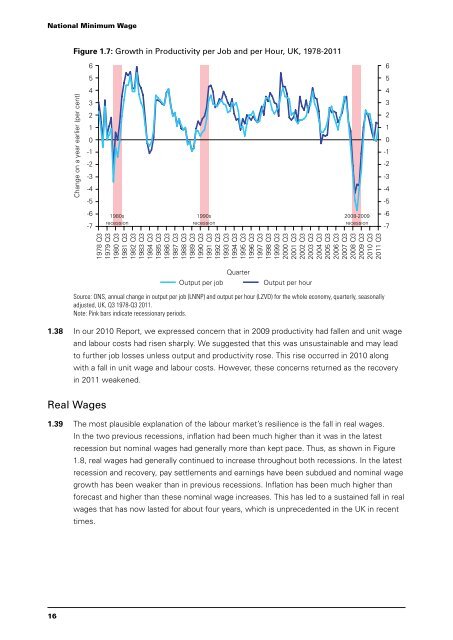National Minimum Wage
National Minimum Wage
National Minimum Wage
You also want an ePaper? Increase the reach of your titles
YUMPU automatically turns print PDFs into web optimized ePapers that Google loves.
<strong>National</strong> <strong>Minimum</strong> <strong>Wage</strong><br />
16<br />
Figure 1.7: Growth in Productivity per Job and per Hour, UK, 1978-2011<br />
Change on a year earlier (per cent)<br />
6<br />
5<br />
4<br />
3<br />
2<br />
1<br />
0<br />
-1<br />
-2<br />
-3<br />
-4<br />
-5<br />
-6<br />
-7<br />
1980s<br />
recession<br />
1990s<br />
recession<br />
1978 Q3<br />
1979 Q3<br />
1980 Q3<br />
1981 Q3<br />
1982 Q3<br />
1983 Q3<br />
1984 Q3<br />
1985 Q3<br />
1986 Q3<br />
1987 Q3<br />
1988 Q3<br />
1989 Q3<br />
1990 Q3<br />
1991 Q3<br />
1992 Q3<br />
1993 Q3<br />
1994 Q3<br />
1995 Q3<br />
1996 Q3<br />
1997 Q3<br />
1998 Q3<br />
1999 Q3<br />
2000 Q3<br />
2001 Q3<br />
2002 Q3<br />
2003 Q3<br />
2004 Q3<br />
2005 Q3<br />
2006 Q3<br />
2007 Q3<br />
2008 Q3<br />
2009 Q3<br />
2010 Q3<br />
2011 Q3<br />
Quarter<br />
Output per job Output per hour<br />
2008-2009<br />
recession<br />
Source: ONS, annual change in output per job (LNNP) and output per hour (LZVD) for the whole economy, quarterly, seasonally<br />
adjusted, UK, Q3 1978-Q3 2011.<br />
Note: Pink bars indicate recessionary periods.<br />
1.38 In our 2010 Report, we expressed concern that in 2009 productivity had fallen and unit wage<br />
and labour costs had risen sharply. We suggested that this was unsustainable and may lead<br />
to further job losses unless output and productivity rose. This rise occurred in 2010 along<br />
with a fall in unit wage and labour costs. However, these concerns returned as the recovery<br />
in 2011 weakened.<br />
Real <strong>Wage</strong>s<br />
1.39 The most plausible explanation of the labour market’s resilience is the fall in real wages.<br />
In the two previous recessions, inflation had been much higher than it was in the latest<br />
recession but nominal wages had generally more than kept pace. Thus, as shown in Figure<br />
1.8, real wages had generally continued to increase throughout both recessions. In the latest<br />
recession and recovery, pay settlements and earnings have been subdued and nominal wage<br />
growth has been weaker than in previous recessions. Inflation has been much higher than<br />
forecast and higher than these nominal wage increases. This has led to a sustained fall in real<br />
wages that has now lasted for about four years, which is unprecedented in the UK in recent<br />
times.<br />
6<br />
5<br />
4<br />
3<br />
2<br />
1<br />
0<br />
-1<br />
-2<br />
-3<br />
-4<br />
-5<br />
-6<br />
-7


